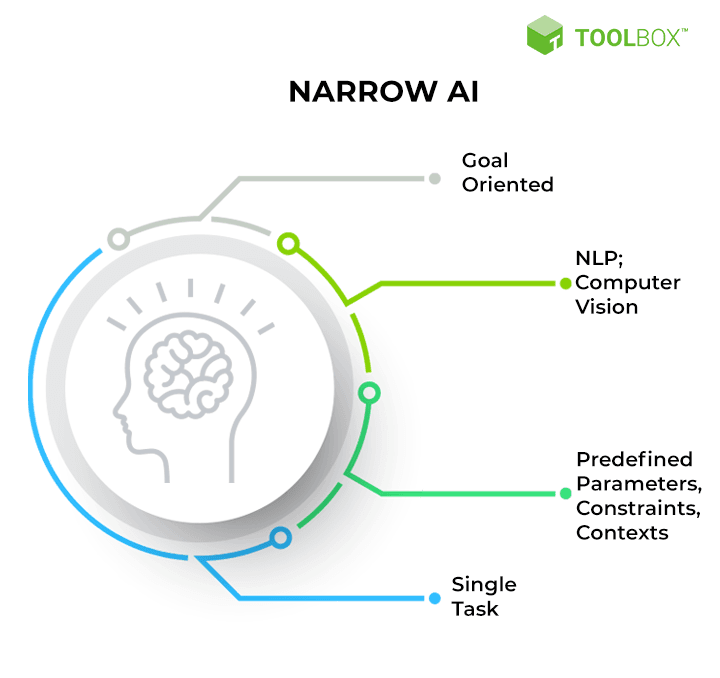What is Narrow AI?
Narrow AI, also known as weak AI, refers to artificial intelligence systems that are designed to perform specific tasks or solve particular problems without possessing general intelligence.
These AI systems excel in their designated tasks, such as image recognition, natural language processing, or playing games, but they lack the ability to understand context or generalize knowledge beyond their training data.
Examples of narrow AI include chatbots, recommendation engines, and self-driving cars. Unlike artificial general intelligence (AGI), which aims to possess human-like cognitive abilities across a wide range of tasks, narrow AI is limited to its predefined domain.
How does Narrow AI Work?

Task-Specific Algorithms
Narrow AI systems use task-specific algorithms to perform their designated functions.
These algorithms can range from simple rule-based systems to more complex machine learning models, depending on the problem being solved.
Data-Driven Approach
Narrow AI often relies on a data-driven approach, where the system learns from large datasets to improve its performance.
By analyzing and processing the data, the AI can identify patterns and make informed decisions based on the input.
Machine Learning Techniques
Various Machine Learning Techniques are employed in narrow AI systems, such as supervised learning, unsupervised learning, and reinforcement learning.
These techniques enable the AI to adapt and improve its performance over time as it processes more data.
Real-World Applications
Narrow AI is widely used in numerous real-world applications, including voice assistants like Siri and Alexa, recommendation systems on platforms like Netflix and Amazon, and even self-driving car technology.
These systems excel in their specific tasks but are not capable of understanding or performing tasks outside their designated domain.
What is the Importance of Narrow AI?
Narrow AI is essential because it allows computers to perform specific tasks more efficiently and accurately than humans.
This can lead to improved productivity and cost savings for businesses.
Who Uses Narrow AI?
Narrow AI is used by various industries and job roles. In this section, we'll discuss the industries that use Narrow AI, the companies that use Narrow AI, and the job roles that require Narrow AI expertise.
Narrow AI is used in various industries, including healthcare, finance, and manufacturing. In healthcare, Narrow AI can be used to analyze medical images and assist with clinical decision-making. In finance, Narrow AI can be used for fraud detection and risk management. In manufacturing, Narrow AI can be used for quality control and predictive maintenance.
Many companies use Narrow AI to improve their products and services. Some examples include Amazon, which uses Narrow AI for its recommendation engine, and Google, which uses Narrow AI for its search algorithms.
Narrow AI is a growing field, and many job roles require Narrow AI expertise. Some examples of Narrow AI job roles include data scientists, machine learning engineers, and AI developers.
How is Narrow AI Used?
Narrow AI is used in various ways, including the use of techniques, tools, and frameworks. In this section, we'll explore how Narrow AI is used and some of the tools and frameworks used in Narrow AI.
Narrow AI Techniques
Narrow AI uses a variety of techniques to perform its designated task or tasks. These techniques include machine learning, deep learning, and natural language processing.
Narrow AI Tools
There are various tools used in Narrow AI, including TensorFlow, Keras, and PyTorch. These tools provide developers with the ability to build and train Narrow AI models.
Narrow AI Frameworks
Narrow AI frameworks provide developers with a set of tools and libraries to build Narrow AI applications. Some examples of Narrow AI frameworks include H2O.ai and Microsoft Cognitive Toolkit.
Narrow AI vs General AI

Narrow AI and General AI are often compared, but they are not the same thing. In this section, we'll explore the differences between Narrow AI and General AI and some of the applications of General AI.
Differences Between Narrow AI and General AI
Narrow AI is designed to perform a specific task or set of tasks, while General AI is designed to perform any intellectual task that a human can do. General AI is still in the research and development stage and is not yet widely used.
General AI Applications
General AI has numerous potential applications, including robotics, autonomous vehicles, and space exploration. These applications require the ability to perform a wide range of intellectual tasks.
Narrow AI Challenges

Limited Generalization and Adaptability
Narrow AI systems struggle to generalize knowledge beyond their training data, making it difficult for them to adapt to new situations or perform tasks outside their specific domain.
Handling Ambiguity and Context
Narrow AI often lacks the ability to understand nuances, ambiguity, or context, which can lead to incorrect interpretations or suboptimal decision-making in complex, real-world scenarios.
Ethical Concerns and Bias
Narrow AI can inherit biases from their training data, potentially leading to unfair or discriminatory outcomes. Addressing these ethical concerns is a significant challenge for AI developers.
Data Privacy and Security
Ensuring data privacy and security is crucial when working with narrow AI systems, as they often process sensitive information. Adhering to regulations and best practices is essential to maintain trust.
Integration and Interoperability
Seamlessly integrating narrow AI solutions into existing workflows and systems can be challenging, requiring effective communication and collaboration between AI and non-AI components to achieve desired outcomes.
Narrow AI Best Practices

Define Specific Goals and Tasks
When developing a narrow AI system, clearly define the specific goals and tasks it will perform. This helps to focus the AI's capabilities and ensures it effectively addresses the intended problem.
Use High-Quality and Diverse Data
Collect high-quality and diverse data for training the AI system. The data should represent various scenarios and edge cases to help the AI generalize and adapt to different situations within its domain.
Choose the Right Machine Learning Techniques
Select the most appropriate machine learning techniques for your narrow AI system based on the problem at hand. Techniques such as supervised learning, unsupervised learning, and reinforcement learning can be employed depending on the specific task.
Monitor Performance and Gather Feedback
Continuously monitor the performance of your narrow AI system and gather user feedback. This helps identify areas for improvement and ensures the AI remains effective and up-to-date with changing requirements.
Prioritize Ethical and Responsible Development
Ensure ethical and responsible development practices when creating narrow AI systems. Consider potential biases, privacy concerns, and other ethical implications while developing the AI to mitigate risks and ensure its safe and responsible use.
By following these best practices for narrow AI, you can create an effective and focused AI system that excels in its designated tasks. Remember to define specific goals, use high-quality and diverse data, choose the right machine learning techniques, monitor performance, and prioritize ethical development to ensure your narrow AI system delivers the best possible results.
Frequently Asked Questions
What is Narrow AI?
Narrow AI, or weak AI, refers to artificial intelligence systems designed to perform specific tasks or solve particular problems, without replicating human intelligence.
How does Narrow AI differ from General AI?
While Narrow AI focuses on single-domain expertise, General AI aims to replicate human intelligence, allowing it to perform a wide range of tasks.
What are some examples of Narrow AI?
Examples of Narrow AI include voice assistants like Siri and Alexa, recommendation systems on platforms like Netflix and Amazon, and self-driving car technology.
Can Narrow AI become General AI?
Narrow AI is not designed to become General AI, as it lacks the broad intelligence and adaptability required to perform tasks outside its designated domain.
Is Narrow AI safe?
Narrow AI is generally considered safe, as its capabilities are limited to specific tasks. However, it's essential to ensure responsible development and usage to mitigate potential risks.

